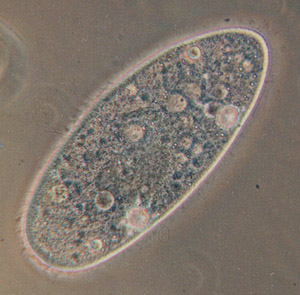![]()
|
Eukaryotes |
Setting Boundaries  Paramecia belonging to the protoctist phylum Ciliophora. One widely supported theory, the endosymbiotic theory, suggests that mitochondria were once free-living bacteria that had developed the ability to use oxygen to make ATP. This conferred such an evolutionary advantage, these bacteria thrived and eventually evolved into aerobic bacteria. It is believed that, over time, these ATP-producing organisms became incorporated into larger cells, perhaps through ingestion. A prokaryote that incorporates into itself an ATP-generating cell gains a definite energy, and evolutionary, advantage. Similarly, a large nonphotosynthetic prokaryote that ingests a photosynthetic prokaryote (a proto-chloroplast) also has a survival advantage. The fact that mitochondria have their own very prokaryote-like single-strand DNA and that their RNA and ribosomes closely resemble those of prokaryotes supports this theory further. Single-celled eukaryotes are classified in the Kingdom Protista, which includes the algae, slime molds, and protozoa. The general characteristics of each group are shown in the following table.
|
|
|
©2007 ABCTE. All rights reserved. |